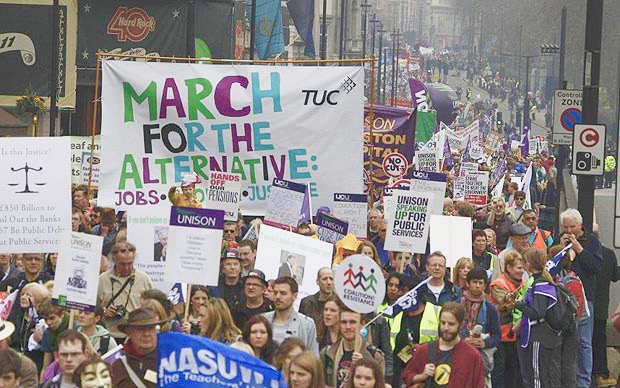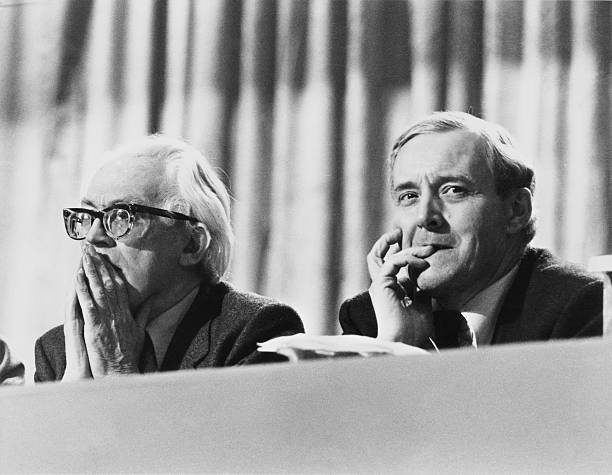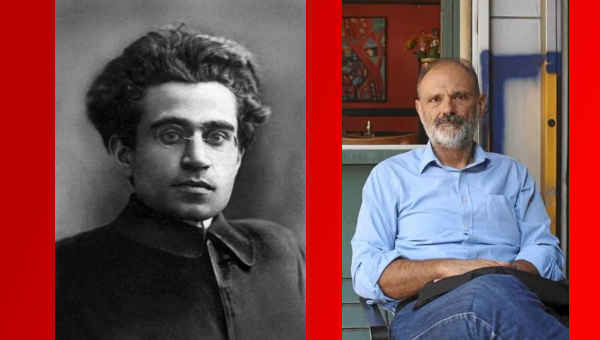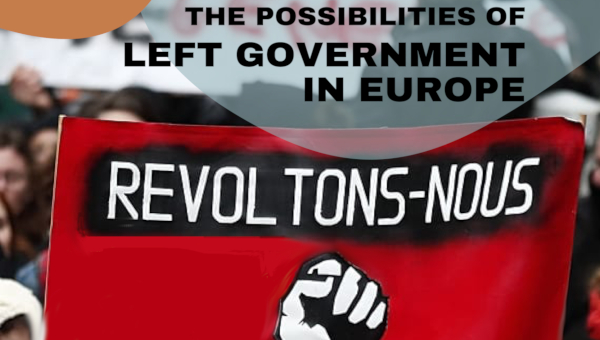A Decade on the Left
The 2010s were the end of ‘the end of history.’ Beginning in the shadow of the largest financial crash since the Great Depression, it was a decade in which the injustice of austerity tore away at the social fabric and consigned third-way politics to the rearview mirror.
In Britain, the decade began with the iconic student protest movement, the rise of UK Uncut and the TUC’s “March for the Alternative.” Soon, these protests against the political and economic order reached global significance with the rise of Occupy Wall Street in New York alongside the movements of the squares in Spain and Greece.
Before long, those countries would be at the forefront of attempts to elect left-wing governments in opposition to the European Union’s austerity measures, attempts which themselves prefigured the rise of Jeremy Corbyn and Bernie Sanders.
It has been a tumultuous period for the Left, one in which it suffered seismic defeats but also gained audiences far in excess of any it had seen since the early 1990s. To assess its ramifications Tribune sat down with Leo Panitch, co-editor of the Socialist Register.
Ronan Burtenshaw (RB): Looking back over the last decade on the Left, you can identify three phases. It begins with the Occupy moment, a horizontalist response to the Financial Crisis which eschewed party politics. Then you have the development from the ‘movements of the squares’ across Europe to new left-wing parties of various kinds, such as SYRIZA in Greece and Podemos in Spain. At the end of the decade, you have this attempt by longstanding left-wingers to win power within the traditional left-of-centre parties in their respective countries, such as in Britain and the United States. How would you characterize these experiences? To what degree do you think progress has been made?
Leo Panitch (LP): I think enormous progress has been made. We saw a movement from protest to politics. It was a short bridge from the police riot against the G20 demonstration here in Toronto in 2010 to Occupy Wall Street and the Spanish indignados a year later. There is a path you can follow from this to Jeremy Corbyn’s election as leader of the Labour Party in 2015 and the Bernie Sanders candidacy in 2016 in the United States.

These were remarkable political developments. People began to realise a decade before, when parties like SYRIZA and Die Linke were formed, that you can protest forever – even with large and impactful protests – without changing the world. The anti-WTO protests began in 1995, then reached their height in Seattle in 1999, these were followed by the mass anti-war protests of the early 2000s. These were evidence that neoliberalism was actually far less popular than people imagined. But as the protests lingered on, people figured out that more was needed. No one sat down and figured it out, or gave instructions to the protestors.
It took some creative leadership, like when Alexis Tsipras said in 2012 ‘we will join with anyone to form a government and stop the torture’ or when Pablo Iglesias said ‘we need to move from the squares to some relationship with the state.’ In the UK it took Corbyn to say, when no other Socialist Campaign Group MP would say it, ‘I’ll run for leadership.’ His campaign in many ways built on years of anti-austerity movements and campaigning, but that moment was able to galvanise something that reached far beyond them. It tapped into a deep enthusiasm for change which those protests represented but which wasn’t capable of changing things fundamentally. Sanders has been much the same in recent years.
Today, even after the defeat in the general election, there are 40,000 members of Momentum. In the United States, similarly, there are 60,000 members of the Democratic Socialists of America. These are things to build on. That is not to say these organizations are always clear politically or know where they are going – they often do not. It is not to say they have done enough to sink deep roots in working-class communities, though many involved want to. But it is an important historical development and it is crucial that Corbyn’s defeat doesn’t lead to their demoralization.
RB: Where does the question of the party stand after this decade? Clearly, one part of what you have just laid out is the movement from the streets into the parties. Yet it has happened in different forms: SYRIZA brought together existing radical left groups, Podemos was a populist party based on digital organizing and a communications strategy, and in Britain it was an attempt to take the historic party of the labour movement back to left-wing politics. What do you make of these different models?
LP: In the 1960s there was this kind of creativity in the streets that led to the creation of historic social movements for liberation and against war. My generation back then already felt that the historic working-class parties had run their course as agents of transformative social change. That wasn’t to say we thought the party apparatuses, the MPs, the councillors, the institutions, didn’t have a long shelf life. We saw that they did. But we recognized that they weren’t going to be transformative any longer.
So we set off on the course of founding new mass parties. Some, not myself, set themselves the task of finding a better Leninism. Others, far fewer in number, tried to find a better Maoism. Some of us tried to found new mass democratic socialist parties, ones that would use the pre-First World War Second International as a model but try not to become so co-opted and oligarchic. My generation, in each of those efforts, failed. The younger generation has embarked on this path again.
It was surprising in some ways – certainly to people like me who had followed previous attempts to transform the Labour Party in the 1970s and ’80s – to see a socialist win the leadership. But he galvanized the same energy that was mobilizing those new parties in other countries in Europe at the time, which was clearly powerful. It is worth pointing out that many of those newer parties are now in deals of various kinds with the old social-democratic parties. In fact, in Spain, they are in coalition government. So there is a kind of coming together of these experiences.
Whichever path was pursued – building new parties or trying to bring the old ones back left – it was never going to be easy. There is a danger that even the new parties in countries with proportional representation voting systems will become ‘social-democratised’ in the bad sense of that word. We can see that now happening with SYRIZA under Tsipras. In some ways, the forces at work inside the Labour Party now and inside the Democratic Party in the United States are more on guard against these tendencies, they are more aware of the old problems of hollowed-out, top-down, centralized parties.
Every time there has been this attempt to transform the Labour Party – and it has happened many times – it has been the result of a great crisis of capitalism. In the early decades of the last century, there was the Great Depression and Ramsay MacDonald taking the party into national government, imposing harsh cuts on unemployment insurance and trying to resolve things from the right. The MacDonald faction became National Labour and the Labour Party itself won only won fifty seats in the 1931 election. Labour then moved left and elected a radical pacifist and socialist, George Lansbury, as its leader.
It was a time of huge unemployment marches and a great desire for change, but Lansbury and the Labour Party in parliament more generally struggled to resonate with the mood outside. Then, just before the 1935 election, Labour conference rejected his line on rearmament – Lansbury was opposed as a pacifist – and he resigned the leadership. Shortly afterwards, Labour regained about 100 seats in the general election under Clement Attlee. Attlee, of course, won the 1945 general election, and led the great post-war Labour government. But, with the exception of Bevan, who of course built the NHS, that was a government in which the Left was largely marginalized.
In that period, even a lot of previously left-wing MPs rapidly accepted the settlement with capital that government oversaw. They accepted that nationalization would be limited and wouldn’t have anything to do with industrial democracy, even though in the early stages the trade unions were voting for workers’ control at Labour conferences. Stafford Cripps, who was one of the founders of Tribune who was seen as a Marxist in the 1930s, became a very conventional chancellor of the exchequer by the end of the 1940s and introduced wage restraint. Bevan, of course, was the exception – he truly managed to carry out a radical reform in building the National Health Service on left-wing lines, although he admitted he had to ‘stuff the doctors’ mouths with gold’ to do it.
The Bevanites, who were then leading Tribune, like Michael Foot, were on the outside of that 1945 government and critical of its limitations. In fact, they stayed on the margins until the 1960s when a former Tribunite in Harold Wilson became prime minister. Some of them joined his cabinet – but it was an extremely disappointing government. It was under Wilson that the contradictions of post-war social democracy first began to show, and the settlement come apart, particularly as finance capital began flooding into London by the end of the 1960s. Under Wilson, wage restraint became almost the main aim of the Labour government, disciplining the trade unions to ensure that the economic crisis didn’t deepen. This got even worse in the 1970s. But by that time the great 1960s protest and social movements had begun to change the political landscape, and galvanize the New Left.

The Bennites, of course, were those who attempted to take these energies into the Labour Party and transform it in a more democratic direction. People like Jeremy Corbyn and John McDonnell were produced by that effort to move the party to the left, learning from and developing on the work of social movements in previous years. That was the most impressive attempt in any social-democratic party anywhere in history, in my view, to take a party that had become ossified and bureaucratized and co-opted by capital and make it a force for change again with democratic socialist politics. Tony Benn had been laying the ground for it since 1969 when he said ‘we need to go beyond the post-war reforms’, that unless we challenged capital and took control over the investment process, we would lose those reforms. He saw neoliberalism before it happened.
Together with the Campaign for Labour Party Democracy (CLPD) Benn fought a decade-long struggle for democracy and socialism inside the party. The CLPD used to say ‘if you can’t democratise the Labour Party, you can’t democratize the British state.’ The Bennites’ attempts to reform the party remain relevant today – making MPs accountable to members with reselection, giving them the right to elect the leader and making the cabinet responsible to Labour conference for its policies. Foot was, in a responsible way, I think, taking the need for party unity on his own shoulders – but we know what happened then.
After Foot, Neil Kinnock came in – another figure who had been on the left, and used his leadership to discipline the Bennites as well as drive others like the Militant Tendency out of the party. This, in turn, laid the foundations for New Labour to emerge in the 1990s. That project ended any idea that Labour would break fundamentally from neoliberalism. The lesson is that it’s very difficult to transform these parties. But there are encouraging signs – the size of Momentum, the role of left-wing unions in supporting Corbynism. There is a lot to be said for fighting to continue the effort in the coming years. But it won’t be done under an effort that puts uniting the party front and centre. That has been the calling card for all previous projects to defeat and marginalize the Left.
RB: I want to ask as well about the working class itself. At the beginning of this decade, in the years after the crash, you had severe austerity programmes across many countries and what remained of the welfare state came under attack. At the same time there was a rise of job casualization and insecure employment, and attacks in many countries – like in Greece, Spain, Britain, France – on the unions themselves. But looking at statistics about the days lost to strike action and union density, there hasn’t been a marked growth in trade union membership or in class struggle. What does that tell us about these left-wing projects of the past decade?
LP: Ultimately, it comes down to the success of the neoliberals in breaking the backs of the trade union militancy that was the response to the economic crisis of the 1970s. That was one big difference between Bennism and Corbynism. In Tony Benn’s case you had a real movement across the country of workplace organizing and struggle, then obviously through the 1980s you also had events like the miners’ strike. But that resulted, as we know, in a great defeat for the trade union movement.
The Thatcher government waged war on the union movement and the question has to be asked: why couldn’t the unions stop it? The answer to that is to be found in how the unions themselves developed over the course of the century, particularly in the post-war period, how they were pulled into corporatist relations with the state and were demobilized in the process. Beyond that, they never became the ‘schools of socialism’ that Marx and Engels had hoped for. Even when they were strong and winning things, they were increasingly winning things for their members so they could fill modern capitalism’s allotted role for them as individual consumers. Members knew, in those days, that the only way to improve terms and conditions was to gather together collectively in your workplace and demand it. But the improvements they demanded were increasingly so that they could participate more actively in the market as individual consumers.
The vision of taking power in the workplace, changing who owned things, solving social needs got progressively lost. The main example of this is, of course, the United States, where unions in some ways were involved in the privatization of the welfare state through healthcare. Workers in unions were given guaranteed insurance coverage through private systems while the public systems were dismantled and workers not in unions got thrown to the wolves. But it isn’t just an American question. When the great class struggles of the 1960s and ’70s happened in Europe, they were largely oriented toward being able to own a refrigerator or buy a car. They were about giving more layers access to this kind of society, rather than changing it. There was an anti-authoritarianism to it as well – I won’t be bossed around, or if you were a woman, I won’t be harassed – but it wasn’t really a political class struggle, aimed at changing which class was in power in society.
During the 1970s, Tony Benn would go to party and trade union conferences and sometimes criticise officials for not educating members about politics and the need for industrial democracy. He would talk more broadly too, he would say ‘do your neighbours know what you do as a trade unionist? Do they know why you do it?’ He was asking the question of whether union members would stick with the union through hard times, whether there was a deeper commitment. If you don’t have trade unions that are involved in class formation, in overcoming the differences between a nurse and a miner, inside the class itself, and building a class for itself, then you’re going to be left with a working-class that can be picked off industry by industry.
When you see this as the backdrop, it’s not hard to understand how precaritization developed in recent years. The demise of the unions and their changing character, too, where a young teacher, no matter how proletarianized, doesn’t have the same class-forming experiences as an industrial worker, creates a very different environment today.
RB: Would it be fair to say we have, in this era, attempted to overcome a relatively low level of class struggle with a political substitute? That’s not to say it was the wrong course of action, but that we elected a socialist leader of the Labour Party without any growth in workplace militancy or the development of a real working-class movement. It’s hard to win on those terms. What can we do in the next ten years to ensure we are not trying to do it all from above again, but that our left-wing projects can be backed by renewed workplace militancy?
LP: We don’t write history on our own terms. I think a lot of people would have hoped that the rise of Corbyn – who consistently backed unions and workers’ issues – would go alongside an increase in workplace activity. Certainly, that was one of the reasons that Corbyn got such strong support from left-wing trade unionists; and many unions in Britain had been coming around to the idea that there was a connection between broader movements and what happens in the workplace, you can see this by the role they played in things like Stop the War and the People’s Assembly.
It is certainly true that huge numbers of young people were galvanized into politics by Corbyn. You have to hope that the capacity is there for them to become active in their workplaces, that they undertake struggles in their own lives and take part in that class formation. Similarly, I was speaking recently to younger members of the DSA in the United States. One of them, Meagan Day, was describing a recent campaign of theirs in California, where they backed a black working-class activist [Jovanka Beckles] for state assembly. They didn’t win, but she said the real value of the campaign was the roots they built in black working-class communities. This meant that, when the teachers’ strike happened in January and February of last year, it was the Oakland DSA that was running the school luncheons outside the picket line, so that the local families didn’t have to cross the picket line to get a meal for their kids.
People are changed through their involvement in projects like the ones around Corbyn and Sanders. The process of trying to build a party that can transform a state itself creates a broader capacity in people to look at the world differently. When you’ve won people over to a project like that, they are prepared to sacrifice – and everyone knows you don’t win a strike without sacrifice. You don’t win a strike without collectivizing a part of your life, either, and that’s what being in a movement means. Strikes are rarely won without collective institutions at a local level, which help people see through a struggle. This is a long and slow process, it involves people dedicating themselves to become organizers.
RB: Arguably, the defining characteristic of Corbynism was its generational politics – that is the sharpest division and most pronounced shift we have seen in the past two elections. Corbyn’s base in the end was young people dealing with real class questions: low wages, high rents, student debt. Many of them saw in Corbyn’s Labour Party a possibility of improving their lives. As someone who has been around decades on the left, what would your advice be to this emerging generation of socialists?
LP: It’s easy to give advice, it’s much harder to follow it. I think this generation really threw itself creatively into electoral politics – not just in 2017 but in 2019 as well – and produced some of the most vibrant campaigns we have seen in a long time. They showed enormous dedication and selflessness. The hard answer to your question is, real change involves doing that on a more permanent basis. That’s difficult to do, especially if you’re in a precarious situation.
But there is a tradition of this on the left. Many of the old organizers were precarious. They went into places they didn’t know, places that needed organizing. They slept on people’s floors and in their attics, they shared food. They were an integral part of building up the collective capacity of workers to engage in class struggle. This can’t be done in isolation – it should be done alongside the trade union movement. I remember one leading figure in Unite once spoke to me about needing to have a Momentum in Unite. Well, when you have all these young people with such enthusiasm, many of whom have difficult working conditions, many of whom are already socialist, trade union leaders should be thinking about how to bring them on board to revitalize their own organizations.
As for Momentum, we need an organization that goes beyond just supporting Corbyn in elections. Or winning reselection and other democratic reforms inside the party. It needs to be permanently engaged in teaching people how to be organizers and in developing its members’ own political education, so they can work at the base to engage in what needs to be seen as class re-formation today. Organizers need to facilitate the process whereby the rider for Uber Eats, the call centre worker, the worker in a warehouse, and erstwhile professionals like teachers, who are being proletarianized, all recognize themselves as part of the new working-class.
I think my greatest piece of advice would be to commit for the long haul. The tenor of the moment is to say ‘we’ve only got five or ten years left’ because of the depth of the climate emergency. That kind of slogan was designed to get people to see how serious things are. But as a political strategy it is a dead end. We can’t think in those terms, no matter how desperate the climate situation. We have to be able to think in terms of ten, fifteen or twenty years. There is fundamental class and organizational rebuilding to be done. It takes time.
Even if Corbyn had won a plurality in December’s election, he would still have been forced to govern not only with the Scottish National Party (SNP) or the Liberals, but with many MPs in his own party who aren’t committed to socialism. How much would he really have been able to do without longer-term organizing happening outside the government? Without rebuilding class institutions? Without political education? We have to be sober about this, it’s a long fight. •





